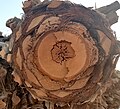Trunk (botany)

In botany, the trunk (or bole) is the stem and main wooden axis of a tree,[1] which is an important feature in tree identification, and which often differs markedly from the bottom of the trunk to the top, depending on the species. The trunk is the most important part of the tree for timber production.
Trunks occur both in "true" woody plants as well as non-woody plants such as palms and other monocots, though the internal physiology is different in each case. In all plants, trunks thicken over time due to formation of secondary growth (or in monocots, pseudo-secondary growth). Trunks can be vulnerable to damage, including sunburn.
Trunks which are cut down in logging are generally called logs and if cut to a specific length bolts. The term "log" is informally used in English to describe any felled trunk not rooted in the ground. A stump is the part of a trunk remaining in the ground after the tree has been felled.
Structure of the trunk
The trunk consists of five main parts: the bark, inner bark, cambium, sapwood, and heartwood.[2] From the outside of the tree working in, the first layer is the bark; this is the protective outermost layer of the trunk. Under this is the inner bark which is made of the phloem. The phloem is how the tree transports nutrients from the roots to the shoots and vice versa. The next layer is the cambium, a very thin layer of undifferentiated cells that divide to replenish the phloem cells on the outside and the xylem cells to the inside. Directly to the inside of this is the sap wood, or the living xylem cells. These cells transport the water through the tree. Finally at the center of the tree is the heartwood. The heartwood is made up of old xylem cells that have been filled with resins and minerals to keep other organisms from growing and infecting the center of the tree.
-
Raft of timber logs
-
Cross section of a hazel bole
-
Log being decomposed by bracket fungi
-
Trunk of an Olive tree
-
Palmae Phoenix dactylifera Trunk section. It's not a real tree, so there are no tree rings
See also
- Bark
- Basal area
- Tree measurement
- Tree volume measurement
- Diameter at breast height
- Log (disambiguation)
References
- ^ "trunk". The Free Online Dictionary. Retrieved 2017-02-17.
- ^ Ward, James. "A Tree and Its Trunk page 2". dendro.cnre.vt.edu. Retrieved 2018-02-08.
External links





